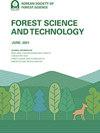Forest-based livelihood choices and their determinants in Western Kenya
IF 2.2
Q2 FORESTRY
引用次数: 6
Abstract
Abstract Forest extraction is an important livelihood activity for millions of low-income households in rural areas of developing countries. Understanding the choices households make to extract forest products can help formulate strategies for preventing livelihood strains associated with forest degradation. This article evaluates the nature, extent and determinants of forest extraction among rural households in western Kenya. Data were obtained from a survey of 924 randomly selected households in the Mt. Elgon area in western Kenya. The level of forest extraction was measured as the aggregate value of products extracted, while a Double Hurdle model was applied to assess the factors influencing forest extraction. The results show that the choice to engage in forest-based livelihood was generally higher among households with lower asset value, membership in forest user associations, and headed by males. The results further show that although the majority of households’ engaging in forest-based livelihood were of the lowest wealth category, households in the middle wealth category were found to extract higher value products. Institutional characteristics, including access to agricultural markets, credit, extension, and membership to forest user groups, increased the likelihood of households’ extracting higher value products. Overall, the results show that in addition to asset endowment, other contextual factors, such as access to markets, agricultural extension, and membership to farmer groups defined whether a household extracted forest products for survival or accumulation.肯尼亚西部森林生计选择及其决定因素
森林采伐是发展中国家农村地区数百万低收入家庭的重要生计活动。了解家庭在提取林产品方面的选择有助于制定战略,防止与森林退化有关的生计压力。本文评估了肯尼亚西部农村家庭森林采伐的性质、程度和决定因素。数据来自对肯尼亚西部埃尔贡山地区随机抽取的924户家庭的调查。森林采伐水平以采伐产品的总和来衡量,并采用双障碍模型对森林采伐的影响因素进行评估。结果表明,资产价值较低、森林使用者协会会员、户主为男性的家庭,从事森林生计的选择普遍较高。研究结果进一步表明,虽然从事森林生计的大多数家庭属于最低财富类别,但中等财富类别的家庭提取的产品价值更高。制度特征,包括进入农业市场、信贷、推广和森林用户群体的成员资格,增加了家庭提取高价值产品的可能性。总体而言,研究结果表明,除了资产禀赋之外,市场准入、农业推广和农民团体成员资格等其他背景因素也决定了一个家庭是为了生存还是为了积累而采伐林产品。
本文章由计算机程序翻译,如有差异,请以英文原文为准。
求助全文
约1分钟内获得全文
求助全文

 求助内容:
求助内容: 应助结果提醒方式:
应助结果提醒方式:


